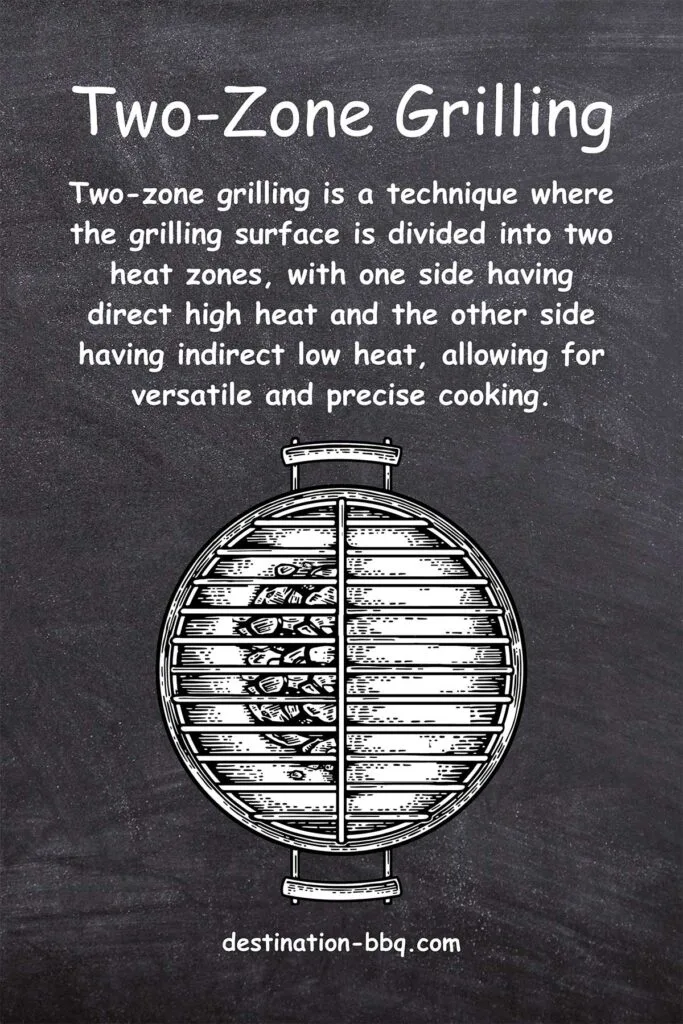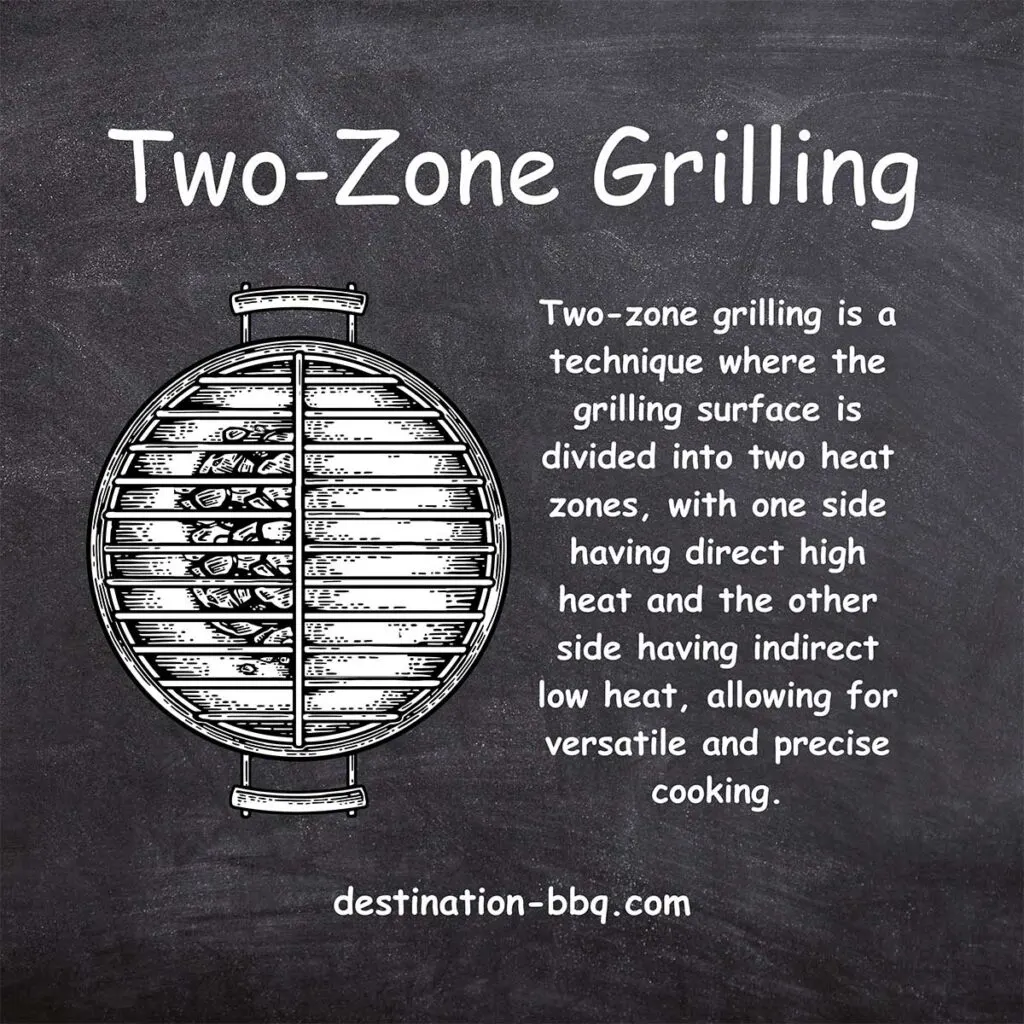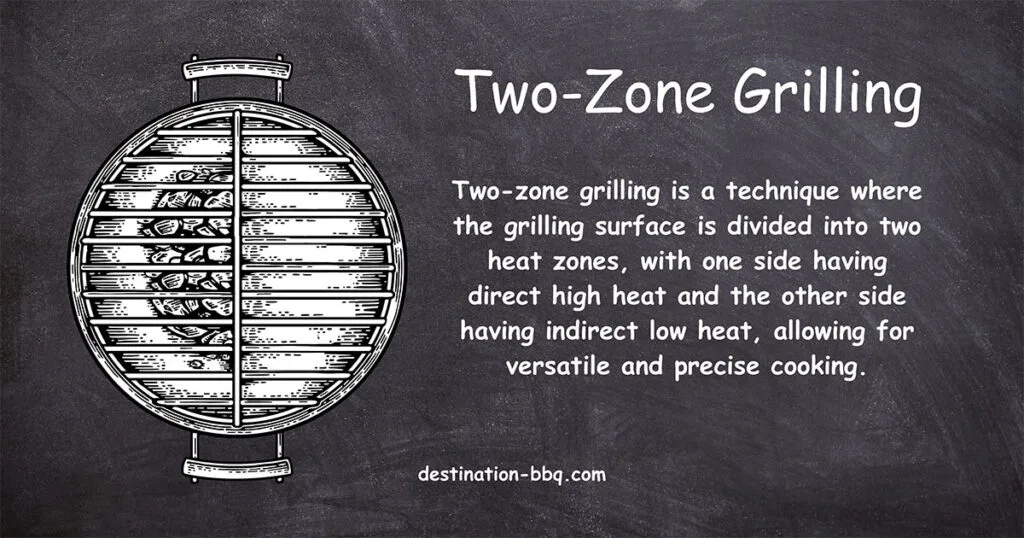
What is 2-Zone Cooking or Grilling?
Two-zone grilling is a method of cooking on a grill where the cooking surface is divided into two distinct heat zones: a direct heat zone and an indirect heat zone. In the direct heat zone, food is placed directly over the flames or heat source for quick searing and browning.
On the other hand, the indirect heat zone involves placing the food away from the direct heat source, allowing for slower and more controlled cooking. This technique provides greater flexibility, enabling simultaneous cooking of different foods with varying cooking requirements, and allows for precise control over the cooking process to achieve optimal results.
Key Takeaways
- Two-zone grilling involves dividing the grill into two heat zones: direct and indirect.
- The direct heat zone is used for quick searing and browning, while the indirect heat zone allows for slower and more controlled cooking.
- This method offers the flexibility to cook different foods simultaneously and provides precise control over the cooking process for optimal results.
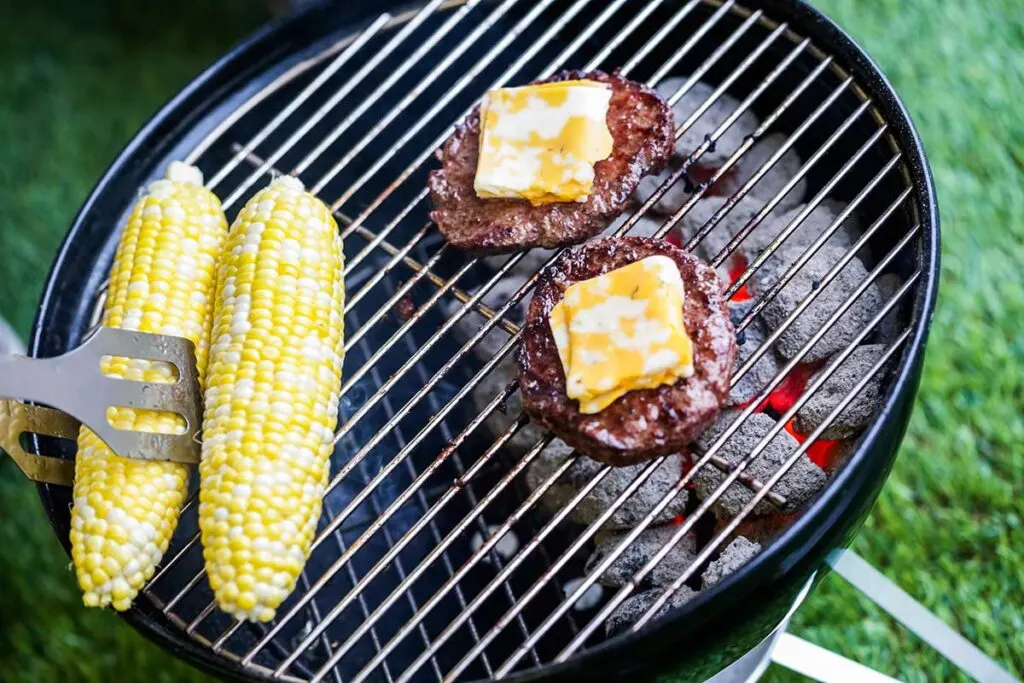
Two-zone grilling is one of those BBQ skills that can completely change your grilling game. By having one side of your grill over direct heat and having the other side over indirect heat, you have better control over how hot and fast your food cooks.
Susie Bulloch, Hey Grill Hey
Understanding Two-Zone Grilling
Imagine the sizzle of juicy steaks hitting the grill, the tempting aroma of perfectly charred vegetables, and the sound of laughter as friends and family gather around, eagerly anticipating a mouthwatering feast. It’s time to put your cooking skills to the test.
But wait… have you ever found yourself faced with the specter of overcooked or undercooked food? We’ve all been there, trying to salvage a hockey puck-like steak or anxiously rushing to finish cooking while hungry guests drum their fingers in anticipation.
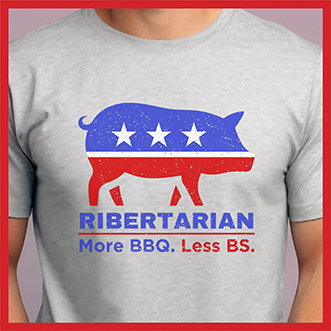
Gifts for Your Favorite Pitmaster
(even if that’s you!)
On
Etsy
Shirts, hats & more designed exclusively by Destination BBQ
Avoid disaster learning 2-zone grilling.
Mark Jenner, the founder and chief editor of FoodFireFriends.com, passionately proclaims, “I never, and not for years now, ever set up a charcoal grill for high heat grilling without an indirect cooler temperature zone.”
Let those words sink in.
You’ll see this technique used by veteran pitmasters all the time. For instance, James Beard Award winner Rodney Scott applies this in his spareribs recipe and in his smoked turkey recipe.
In this comprehensive guide, we’ll share the secrets of 2-zone cooking, showing you how to divide your grill into two distinct zones and apply different levels of heat to each. It’s like having the best of both worlds – the sizzling intensity of direct heat and the gentle embrace of indirect heat.
We’ll walk you through the science, the setup, the techniques, and even the pitfalls to avoid. Are you ready to take your grilling skills to new heights? Let’s dive into the smoky realm of two-zone grilling.
The Science Behind 2-Zone Grilling
Now, let’s delve into the science behind two-zone grilling and understand why it’s a trusted technique for veteran pitmasters.
Meathead, the publisher of amazingribs.com and author of Meathead, The Science of Great Barbecue and Grilling, explains the importance of temperature control: “To cook delicious food, you need to control your cooking temperature because the compounds in foods react differently to different levels of heat.”
Each component of the foods you put on the grill – proteins, fats, sugars, and more – undergoes remarkable transformations at different temperatures.
For example, fats render, water evaporates, collagens melt, sugars caramelize, the Maillard reaction occurs (browning), and carbonization (charring) becomes a risk. Achieving the ideal temperature for each component is the key to unlocking mouthwatering flavors and textures.
Here’s where the 2-zone cooking setup helps. It provides you with precise control over temperature. By creating two distinct zones on your grill – a direct heat zone and an indirect heat zone – you can tailor the cooking environment to suit the specific needs of different foods.
In the words of Meathead, “Using a 2-zone grilling setup allows us to control the temperature applied to the food. We can gently heat a turkey in the indirect zone, get it cooked to juicy, tender, smoky perfection, and be the heroes of Thanksgiving.”
Imagine the possibilities…
Slowly roasting a big prime rib to medium-rare with a perfect crust, tenderizing tough cuts of meat without drying them out, or crisping up chicken skin to golden brown. With two-zone grilling, all of that and more is possible.
But it’s not just about temperature control. The two-zone setup also allows you to cook multiple foods simultaneously, each requiring different cooking times and heat levels.
Meathead emphasizes the versatility of this technique, stating, “A 2-zone grilling setup is especially handy if you have more than one food cooking at once, where the thickness and water content of the two is significantly different so they will cook at different rates.”
With the power of two-zone cooking, you can cater to different preferences and ensure each dish is cooked as it should be.
With practice, this technique will improve your food. Control and precision make all the difference.
Setting Up Your Grill for 2-Zone Grilling

Whether you’re working with a charcoal grill, a gas grill, or even an electric grill, the principles remain the same: divide your grilling surface into two distinct zones, each offering different heat levels.
Meathead sheds light on this essential step, stating, “When you shop for a grill, you must get one that allows you to configure it in two zones.” It’s crucial to ensure that your grill provides the flexibility necessary for this technique, allowing you to create a direct heat zone and an indirect heat zone.
Here’s how you can set up your grill:
Charcoal Grill
- Get your charcoal going until it’s white-hot using a charcoal chimney starter.
- Instead of spreading the coals evenly across the lower grate, bank the coals all to one side of the grill. This concentrated pile of coals will serve as your direct heat zone.
- The other side, where there are no coals, will be your indirect heat zone.
Gas Grill
- If you have a gas grill with multiple burners, turn only one or two burners on high to create the direct heat zone.
- Leave the remaining burners off to establish the indirect heat zone.
- Meathead suggests, “You may find that you can hit the 225°F mark with a three-burner gas grill by turning one burner on medium and the other two off. Or maybe it needs to be on low.”
- Take the time to familiarize yourself with your specific grill and the settings required to achieve the desired temperature differentials.
Electric Grill
- Electric grills typically have heating elements that cover the entire grilling surface.
- To create a two-zone setup, you can use physical barriers like heat-resistant dividers or foil-wrapped bricks to create a direct heat zone and an indirect heat zone.
- Position the heating elements beneath one side of the grill to establish the direct heat zone, while leaving the other side without direct heat for the indirect zone.
Remember, understanding the unique configuration of your grill and mastering the temperature differentials are essential. As Meathead notes, “You need to get to know your instrument and master the concept.” Practice and experimentation will help you fine-tune the setup that works best for your specific grill.
With your grill set up with a 2-zone fire, you’re now equipped to take full control over the cooking process, ensuring each food item receives the ideal heat treatment. In the next section, we’ll explore the art of mastering the different heat zones and the culinary possibilities they offer.
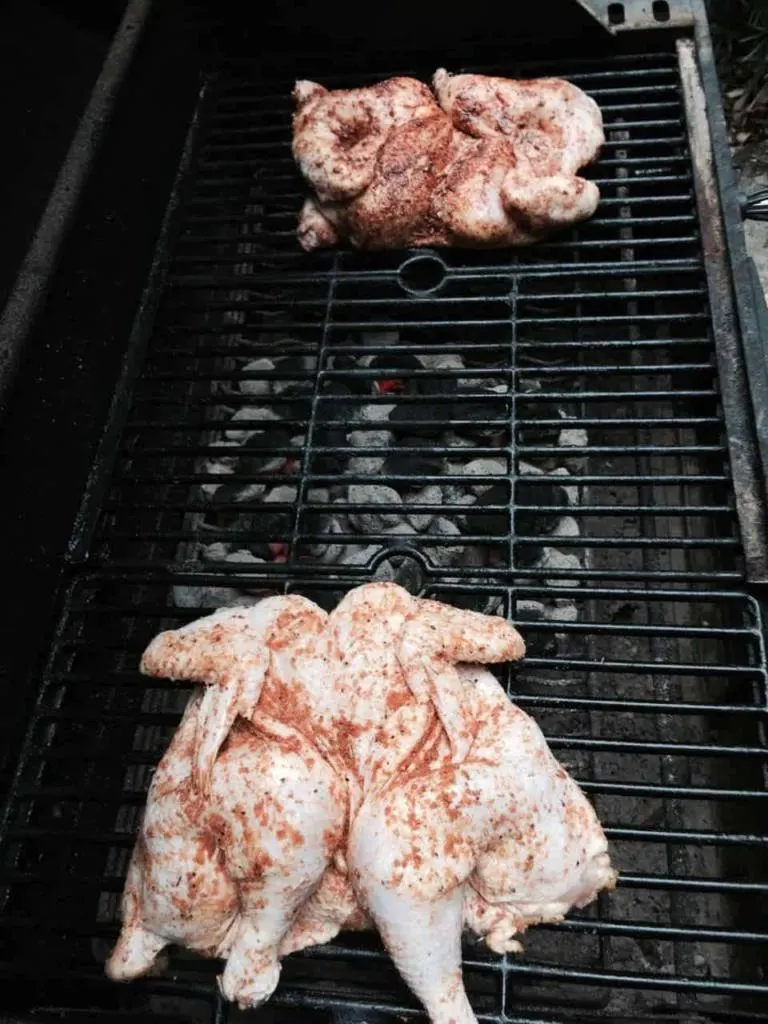
Mastering the Two Heat Zones
Now that you have your grill set up for two-zone smoking, it’s time to understand the unique characteristics of each heat zone and how to leverage them. The direct heat zone and the indirect heat zone each play a crucial role in achieving optimal results.
Direct Heat Zone
The direct heat zone is where the flames or heating elements directly heat the food, creating intense radiant heat. This zone is perfect for quick searing, achieving beautiful grill marks, and adding that coveted caramelization.
Jenner emphasizes the versatility of the direct heat zone, stating, “You always have that high heat option on the other side of the grill if you need it.”
Indirect Heat Zone
On the other side of the grill lies the indirect heat zone, where there is no direct heat source beneath the food. This zone relies on convection heat, similar to an oven, to cook food gently and evenly.
Meathead highlights the benefits of the indirect heat zone, stating, “It allows us to control the temperature applied to the food… we can cook large slow-cooking pieces alongside small quick-cook veggies and small pieces of meat.”
By utilizing both heat zones, you gain unparalleled control over the cooking process. Here’s how to harness the power of each zone:
Direct Heat Zone
- Place foods that benefit from high heat and quick cooking in this zone, such as burgers, thin steaks, fish fillets, and vegetables.
- Flip the food as needed to ensure even cooking and achieve desired browning or searing.
- Remember to keep a close eye on foods in the direct heat zone to prevent burning or overcooking.
Indirect Heat Zone
- Foods that require slower and more gentle cooking shine in the indirect heat zone. This includes larger cuts of meat like Boston butts, whole chickens, spare ribs or baby back ribs, and brisket.
- Start these foods in the indirect heat zone to allow for thorough cooking without excessive charring or drying out.
- After the initial phase of cooking in the indirect zone, you can finish certain items in the direct heat zone to enhance texture and create a flavorful crust.
The beauty of this method is that it provides the flexibility to simultaneously cook different foods with varying cooking times and requirements. You can keep foods warm in the indirect zone while others continue to cook in the direct zone.
As Jenner rightly puts it, “You keep everyone happy” by catering to individual preferences and ensuring each item is cooked to perfection.
Temperature Control and Calibration
Controlling temperature is crucial for success in barbecue. While grilling outdoors presents unique challenges, understanding temperature dynamics and implementing proper calibration techniques can greatly improve your finished product.
One of the keys to temperature control is calibrating your grill or smoker. As Meathead, the renowned grilling expert, advises, “The first thing to do after you assemble your new grill or smoker is to season it and calibrate it by doing a few dry runs without food.” This process helps burn off any residual manufacturing grease and allows you to familiarize yourself with the grill’s temperature patterns.
Since every grill is different, it’s essential to use a reliable thermometer for accurate temperature readings.
As Jenner emphasizes, “You cannot trust your grill’s thermometer. You absolutely must get a good digital thermometer for your grill.” Investing in a quality digital thermometer will provide you with accurate temperature readings, enabling you to fine-tune your cooking process.
(We recommend the Thermapen One.)
In outdoor grilling, external factors like weather conditions can impact temperature control. Sun, wind, rain, or snow can all affect the grill’s heat distribution and overall cooking temperatures. Therefore, it’s crucial to be aware of these elements and make adjustments accordingly.
As Meathead points out, “Outdoor grilling is less of a perfect science than your kitchen oven cooking,” so being adaptable and making adjustments based on real-time conditions is key.
Remember, temperature control is not a one-size-fits-all approach. It requires some trial and error to understand your specific grill’s behavior and how it responds to different settings. Experimenting with different burner configurations, coal arrangements, or heat adjustments will help you achieve the desired temperature ranges for your direct and indirect zones.
By paying attention to temperature control, calibrating your grill, and using reliable thermometers, you’ll gain the confidence and ability to fine-tune your grilling technique, ensuring perfectly cooked and flavorful results every time.
Stay tuned for the next section, where we’ll share additional expert tips and insights.
Expert Tips and Insights
To truly master the art of 2-zone grilling, it’s valuable to glean wisdom and insights from experienced grillmasters, chefs, and experts in the field. Their tips and advice can help you refine your techniques and elevate your grilling game. Here are some things to consider:
- “Two-zone grilling also provides you with a ‘safety net,'” writes David Johnson on Barbecue Logic. “Maybe the flame is suddenly flaring, and the temperature is getting a little out of hand, move it to the indirect zone until you regain control.”
- Jenner highlights the significance of experimentation: “Every grill is different, and you may need to experiment with burner configurations or coal arrangements to achieve the right balance of high and low heat. Don’t be afraid to adjust and fine-tune to find what works best for your specific grill.”
- Seasoned grillmasters recommend using a water pan in the indirect zone to add moisture and flavor to your dishes. According to Meathead, “A water pan adds humidity to the cooking atmosphere, keeping the meat moist and juicy. It also helps absorb heat, helping to maintain a lower temperature in the indirect zone.”
- When it comes to transitioning between zones, renowned chefs advise being mindful of timing and temperature considerations. As Meathead suggests, “Move your food to the direct zone at the right moment to achieve the desired sear and caramelization. Be attentive and watch for the perfect balance of searing, cooking, and finishing.”
By incorporating these expert tips and insights into your approach, you’ll gain a deeper understanding of the nuances involved and refine your skills to create memorable, mouthwatering dishes that will impress family and friends.
« See Full Glossary Index